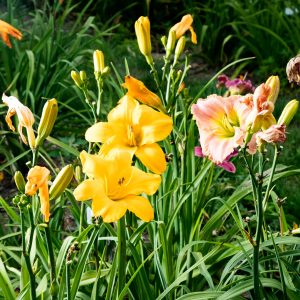How To Grow Daylilies
If you think you’ve been cursed with a “black thumb”, the daylily is the plant for you! I’ve seen daylilies tossed into a compost pile with roots up and green-side down, turn themselves around and bloom the following year. Still, that’s probably not the best way to treat your newly purchased beauties.
Your plants will have had all the dirt washed from the roots to comply with USDA shipping requirements. Soak the roots of the daylilies in a couple inches of water for an hour or two, or until you can plant them. Daylilies can be held in water for several days if necessary, but the sooner you get them in the ground, the better.

PLANTING: Dig a reasonable sized hole so that the daylily roots aren’t cramped. Prepare the soil by adding some organic matter (ex.: compost, peat moss, composted manure) and mix well into the soil. Make a cone-shaped mound in the bottom of the hole and spread the roots out over it. Make sure the crown (where the roots meet the foliage) is just at the surface of the soil. If you plant too deep, the daylily may not flower well. Add the amended soil mix, and using your fingers, push the soil around the roots. Jiggle the plant a bit to help the soil fill in well. Continue filling and tamping until the hole is completely filled and the plant feels secure if you give it a light tug. Water well, and keep plants moist for the first two weeks.
WHERE TO PLANT? Daylilies love full sun, but will tolerate shade. They won’t bloom as profusely, but will survive and flower. If you plant under trees and shrubs, remember they will be competing with neighboring roots for water and nutrients, so make sure you compensate by adding extra.
FOOD FOR THOUGHT: Daylilies enjoy a spring fertilization when the plants are up about 6″. You can use lawn fertilizer (high in nitrogen) or a basic 5-10-5 or 10-10-10. Water soluble fertilizers are fine as well. Daylilies aren’t very choosy!
IN THE LONG RUN: Mulch will help keep weeding chores down and preserve moisture…specially good for sandy soils. Remove spent blossoms to prevent seeds from starting new and not necessarily desirable plants in your bed. Divide daylilies whenever they seem to be crowding their neighbors; when the size and number of the blooms diminish, or when you’d like to share plants. Make sure each division includes both roots and foliage. A double fan division will establish more quickly than a single fan. Remember to amend the soil with organic matter when re-planting. Daylilies are best divided either in the spring, or in early fall after flowering has finished. In the deep south, winter is often the best time for division.
